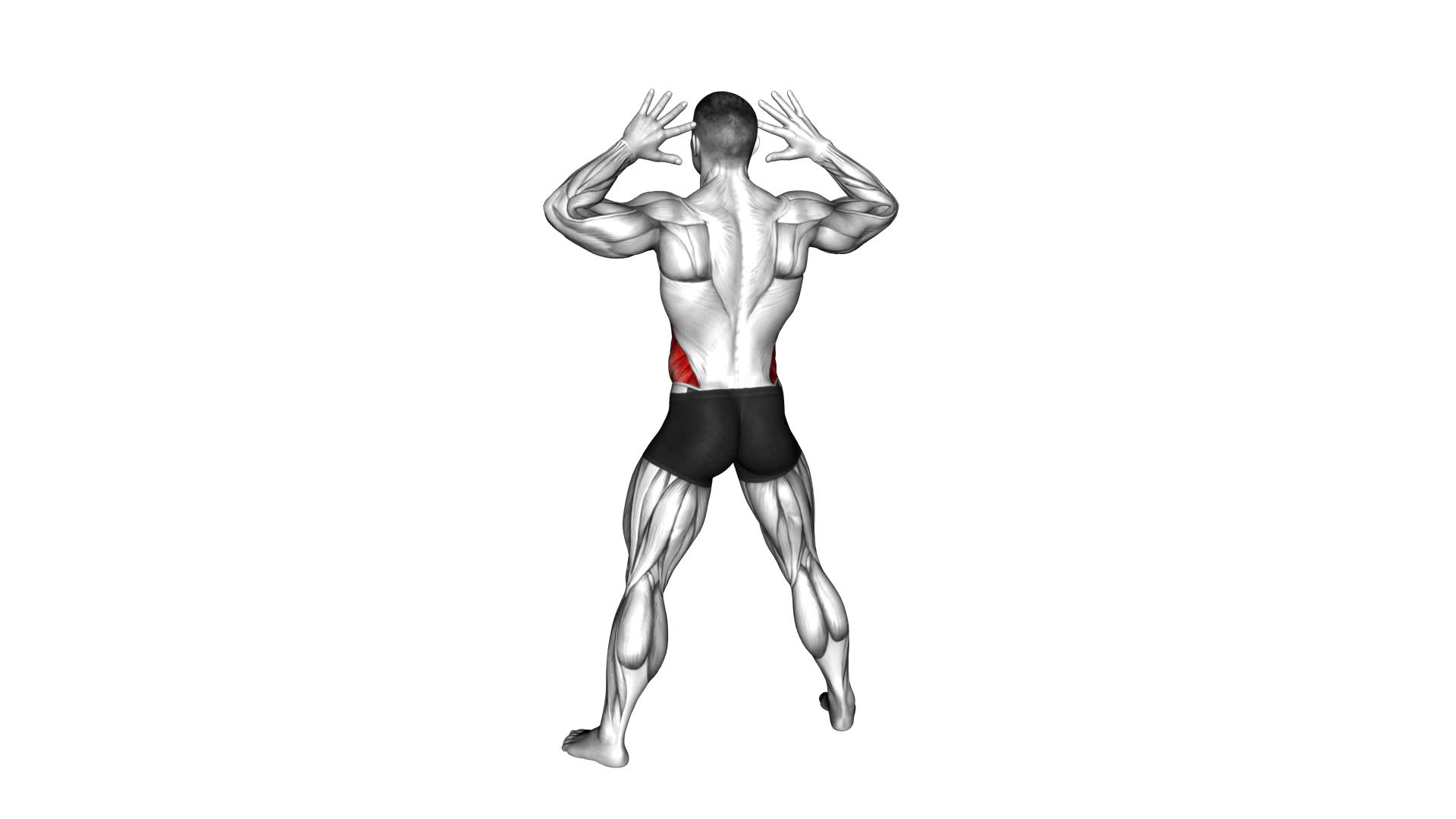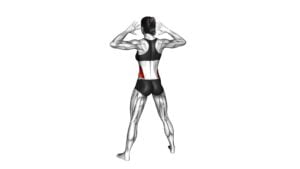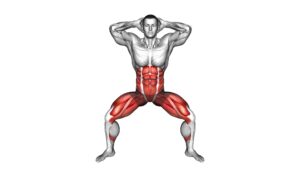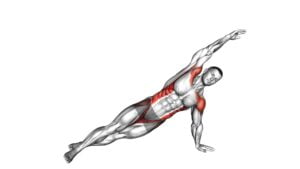Ear to Knee Side Bend (male) – Video Exercise Guide & Tips

Get ready to tone your abs with the Ear to Knee Side Bend exercise. In this video exercise guide, we'll show you the proper technique and form for this effective move.
Watch This Exercise Video
Whether you're a beginner or more advanced, we've got modifications to suit your fitness level.
Plus, we'll share tips to help you get the most out of this exercise and avoid common mistakes.
Let's get started on sculpting those abs!
Key Takeaways
- The Ear to Knee Side Bend exercise improves flexibility and strengthens core muscles, particularly targeting the obliques.
- Variations and modifications, such as using dumbbells or a stability ball, can be incorporated to increase resistance and engage the core more intensely.
- Safety tips include using a non-slip surface, modifying the exercise according to injuries or health conditions, and warming up before performing the exercise.
- Proper technique and form, such as maintaining correct spinal alignment, engaging the core, and avoiding rounding or arching the spine, are crucial for effectiveness and to prevent strain or injury.
Benefits of the Ear to Knee Side Bend
By practicing the Ear to Knee Side Bend, you can experience a range of benefits to improve your flexibility and strengthen your core. This exercise primarily targets the obliques, which are the muscles on the sides of your abdomen. By engaging these muscles, you can achieve a leaner waistline and improve your overall posture. Additionally, the Ear to Knee Side Bend helps to increase spinal mobility and flexibility, reducing the risk of back pain and injury.
As you bend sideways, you also engage your hip abductors and adductors, which are responsible for moving your legs away from and towards your body. This exercise can help to tone and strengthen these muscles, improving your stability and balance.
To add variation to your workout, you can perform the Ear to Knee Side Bend with different equipment or modifications. For example, you can use dumbbells or a resistance band to add resistance and increase the challenge. You can also perform the exercise on a stability ball to engage your core muscles even further. Another variation is to perform the exercise in a kneeling position, which puts more emphasis on your core and increases the stability challenge. These variations allow you to continually challenge your body and prevent boredom in your workout routine.
Now that you understand the benefits and variations of the Ear to Knee Side Bend, let's discuss the equipment needed for this exercise.
Equipment Needed for the Exercise
To perform the Ear to Knee Side Bend exercise, you'll need a yoga mat or a comfortable surface to lie on. This will provide cushioning and support for your body during the exercise. It's important to have a non-slip surface to prevent any accidents or injuries. Additionally, you may need a towel or a small pillow to support your head and neck if needed.
When it comes to exercise modifications, it's important to listen to your body and make any necessary adjustments. If you have any existing injuries or health conditions, it's advisable to consult with a healthcare professional or a certified fitness instructor before attempting this exercise. They can provide guidance on how to modify the exercise to suit your individual needs and abilities.
In terms of safety precautions, it's important to warm up before performing the Ear to Knee Side Bend exercise. This will help to prepare your muscles and joints for the movements involved. It's also important to maintain proper form throughout the exercise to avoid strain or injury. If you experience any pain or discomfort during the exercise, it's important to stop immediately and seek professional guidance. Remember to always listen to your body and prioritize safety when engaging in any physical activity.
Proper Technique and Form for the Exercise
To perform the Ear to Knee Side Bend exercise with proper technique and form, it's important to focus on maintaining correct spinal alignment throughout the movement.
Engage your core muscles to stabilize your body and avoid excessive strain on your neck and back.
Correct Spinal Alignment
When performing the Ear to Knee Side Bend exercise, it's important to maintain correct spinal alignment in order to prevent injury and maximize the effectiveness of the movement. Proper spinal alignment is crucial for improving posture and ensuring that the exercise targets the intended muscles.
To achieve correct spinal alignment, start by sitting tall with your back straight and shoulders relaxed. As you bend sideways to bring your ear towards your knee, focus on keeping your spine straight and avoiding any rounding or arching. Imagine a straight line running from the top of your head to your tailbone.
Engaging your core muscles can also help support your spine and maintain proper alignment. This will be discussed in the next section.
Engaging Core Muscles
To engage your core muscles properly for the Ear to Knee Side Bend exercise, focus on contracting your abdominal muscles throughout the movement. This will help you maintain core stability and strengthen your oblique muscles.
As you perform the exercise, imagine pulling your belly button towards your spine, creating a feeling of tightness in your midsection. This engagement of the core will provide stability and support to your spine, preventing any excessive twisting or bending.
By actively contracting your abdominal muscles, you'll also increase the effectiveness of the exercise and target your oblique muscles more effectively.
Remember to breathe steadily and maintain proper form throughout the movement to maximize the benefits and minimize the risk of injury.
Avoiding Excessive Strain
Engage your core muscles properly by maintaining proper technique and form for the Ear to Knee Side Bend exercise. By following these guidelines, you can prevent injury and reduce muscle tension:
- Stand with your feet shoulder-width apart and your knees slightly bent.
- Place your hands behind your head, interlocking your fingers.
- Slowly bend sideways from your waist, aiming to bring your ear towards your knee.
- Keep your upper body straight and avoid leaning forward or backward.
By performing the Ear to Knee Side Bend exercise with proper technique and form, you can protect your muscles and joints from excessive strain. This will help you maximize the benefits of the exercise while minimizing the risk of injury.
Now, let's explore modifications for beginners to gradually build strength and flexibility.
Modifications for Beginners
Let's talk about modifications that can help beginners ease into the Ear to Knee Side Bend exercise. These simplified modifications are designed to make the exercise more accessible while maintaining safety.
Additionally, we'll provide some helpful tips to ensure beginners perform the exercise correctly and minimize the risk of injury.
Simplified Beginner Modifications
Start with the basics and make modifications to the ear to knee side bend exercise to better suit beginners. Here are four beginner-friendly alternatives and gentle modifications to try:
- Standing Side Bend: Stand with your feet hip-width apart and gently lean to one side, keeping your core engaged and your shoulders relaxed.
- Supported Side Bend: Sit on a chair or bench and place one hand on the seat. Lean to the opposite side, feeling a stretch along your side.
- Seated Side Bend: Sit on the floor with your legs extended. Bend to one side, reaching your hand towards your knee. Keep your spine long and breathe deeply.
- Wall Side Bend: Stand with your side against a wall. Lean sideways, allowing the wall to support your body weight.
By starting with these modifications, you can gradually build strength and flexibility before attempting the full ear to knee side bend.
Now, let's move on to some safety tips for beginners.
Safety Tips for Beginners
To ensure the safety of beginners, it's important to consider modifications and follow these helpful tips for the ear to knee side bend exercise.
- When starting this exercise, it's crucial to listen to your body and not push yourself too hard.
- Begin with a gentle stretch and gradually increase the range of motion as your body becomes more flexible.
- Keep your movements slow and controlled, avoiding any jerky or sudden motions that could lead to injury.
- It's also important to engage your core muscles throughout the exercise to provide stability and support for your spine.
- If you feel any pain or discomfort, stop immediately and consult a fitness professional.
Progression Options for Beginners
To progress as a beginner, you can modify the ear to knee side bend exercise by gradually increasing the range of motion and intensity. Here are four modified variations that can help you gradually improve your strength and flexibility:
- Start with a smaller range of motion: Instead of aiming to touch your ear to your knee, begin by reaching towards your shin or ankle. As you become more comfortable and flexible, you can gradually work towards touching your ear to your knee.
- Use a support prop: Place a yoga block or a rolled-up towel under your knee for added support. This can help you maintain stability and prevent any strain or discomfort as you work on the exercise.
- Reduce the intensity: Instead of lifting your leg off the ground, keep your foot on the floor and focus on bending sideways towards your knee. This modification allows you to build strength and flexibility without putting excessive strain on your muscles.
- Incorporate controlled breathing: Take deep breaths as you perform the exercise, exhaling as you bend towards your knee. This can help you relax and improve your overall form and technique.
Tips for Maximizing the Effectiveness of the Exercise
To maximize the effectiveness of the Ear to Knee Side Bend exercise, ensure you maintain proper form throughout the movement. This will help you to target the correct muscles and avoid injury.
Start by sitting on the floor with your legs extended in front of you. Keep your back straight and engage your core.
As you bend to the side, reach your ear towards your knee while keeping your shoulders relaxed. Remember to breathe deeply and exhale as you reach towards your knee. This will help you to engage your core and increase the effectiveness of the exercise.
Additionally, focus on performing the movement slowly and with control. This will allow you to fully engage the targeted muscles and get the most out of each repetition.
As you progress, you can increase the intensity of the exercise by holding a dumbbell in your hand or by using a resistance band.
Common Mistakes to Avoid While Performing the Exercise
Avoid these common mistakes while performing the Ear to Knee Side Bend exercise to ensure proper form and maximize results. Here are four things to watch out for:
- Rounding your back: One of the most common mistakes is rounding your back during the exercise. This not only reduces the effectiveness of the movement but also puts unnecessary strain on your spine. Keep your back straight throughout the entire range of motion.
- Using momentum: Another mistake to avoid is relying on momentum to complete the exercise. Remember, it's not about how fast you can do it, but rather the quality of the movement. Slow and controlled is the key here.
- Neglecting your core: Proper technique requires engaging your core muscles. Make sure to activate your abs and obliques as you perform the side bend. This will help stabilize your spine and prevent any undue stress on your lower back.
- Overarching your neck: Lastly, be mindful of your neck position. Avoid arching your neck excessively or straining it forward. Keep your neck in a neutral position, aligned with your spine, to maintain proper alignment and prevent neck strain.
Frequently Asked Questions
How Often Should I Perform the Ear to Knee Side Bend Exercise?
To get the most out of the ear to knee side bend exercise, it's important to know how often to perform it.
The benefits of this exercise include improving flexibility and strengthening your oblique muscles.
For proper form and technique, make sure to sit tall with your legs extended and bend sideways from your waist, aiming to touch your ear to your knee.
As for frequency, aim for 2-3 sets of 10-15 reps, 2-3 times a week.
Can This Exercise Help in Reducing Belly Fat?
The ear to knee side bend exercise can be effective for overall weight loss. It targets the abdominal muscles and can help reduce belly fat. While it's a beneficial exercise, it's important to note that spot reduction isn't possible, and overall weight loss requires a combination of exercises and a healthy diet.
Comparing it to other belly fat reduction exercises, the ear to knee side bend can be a valuable addition to your fitness routine.
Is It Safe to Perform the Ear to Knee Side Bend Exercise if I Have Lower Back Pain?
Yes, it's important to consider your lower back pain before performing the ear to knee side bend exercise.
While this exercise can be effective for strengthening your core and obliques, it may not be safe for everyone with lower back pain.
It's recommended to consult with a healthcare professional or a certified trainer to determine if modifications or alternative exercises are necessary to avoid aggravating your lower back pain.
Can This Exercise Be Beneficial for Improving Flexibility?
Stretching benefits are an integral part of flexibility training techniques.
Incorporating exercises like the ear to knee side bend can be beneficial for improving flexibility. This exercise targets the muscles in your side and lower back, helping to increase range of motion and promote better posture.
By regularly performing this exercise, you can gradually enhance your flexibility and reduce the risk of muscle imbalances or injuries.
Remember to consult a professional if you have any underlying conditions or concerns.
Are There Any Variations of the Ear to Knee Side Bend Exercise for Advanced Fitness Levels?
Looking to take your ear to knee side bend exercise to the next level? For advanced fitness levels, there are several variations that can challenge your body even more.
Try incorporating advanced modifications, such as using resistance bands or weights, to increase the intensity.
You can also explore equipment variations, like using a stability ball or Bosu ball, to engage more muscles and improve balance.
These modifications can help you further improve flexibility and overall fitness.
Conclusion
In conclusion, the ear to knee side bend exercise is a beneficial movement for strengthening the core and improving flexibility. It requires no equipment and can be modified for beginners.
By following proper technique and form, and avoiding common mistakes, you can maximize the effectiveness of this exercise. Remember to always listen to your body and consult a professional before starting any new exercise routine.

Author
Years ago, the spark of my life’s passion ignited in my mind the moment I stepped into the local gym for the first time. The inaugural bead of perspiration, the initial endeavor, the very first surge of endorphins, and a sense of pride that washed over me post-workout marked the beginning of my deep-seated interest in strength sports, fitness, and sports nutrition. This very curiosity blossomed rapidly into a profound fascination, propelling me to earn a Master’s degree in Physical Education from the Academy of Physical Education in Krakow, followed by a Sports Manager diploma from the Jagiellonian University. My journey of growth led me to gain more specialized qualifications, such as being a certified personal trainer with a focus on sports dietetics, a lifeguard, and an instructor for wellness and corrective gymnastics. Theoretical knowledge paired seamlessly with practical experience, reinforcing my belief that the transformation of individuals under my guidance was also a reflection of my personal growth. This belief holds true even today. Each day, I strive to push the boundaries and explore new realms. These realms gently elevate me to greater heights. The unique combination of passion for my field and the continuous quest for growth fuels my drive to break new ground.







